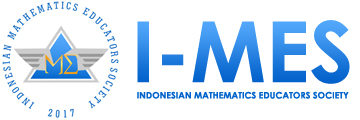EFEKTIVITAS E-MODUL ANALISIS REAL PADA PROGRAM STUDI PENDIDIKAN MATEMATIKA UNIVERSITAS KANJURUHAN MALANG
DOI:
https://doi.org/10.35706/sjme.v1i1.554Abstract
Fokus penelitian ini adalah mengoptimalkan peran bahan ajar dengan mengembangkan dalam bentuk e-modul pada Program Studi Pendidikan Matematika Universitas Kanjuruhan Malang. Secara harfiah, e-modul dapat dimaknai sebagai modul elektronik, non cetak dan hanya berupa file yang dapat dibuka dengan bantuan media elektronik seperti Tablet, Smartphone, komputer PC dan media elektronik lain berbasis sistem operasi terutama Android. Salah satu perkuliahan yang mempunyai keterbatasan handout serta mempengaruhi kompetensi mahasiswa adalah mata kuliah Analisis Real. Model pengembangan yang digunakan dalam pengembangan modul pembelajaran ini adalah model pengembangan yang dirumuskan oleh Thiagarajan dengan model 4-D yang langkah-langkahnya meliputi Define, Design, Develop, Disseminate. Hasil kuisioner menunjukkan persentase modul pembelajaran. sebesar 82,05% yang mengindikasikan bahwa e-modul berada dalam kualifikasi baik.
The focus of this study is to optimize the role by developing teaching materials in the form of e-modules in Mathematics Education Kanjuruhan University of Malang. Literally, e-modules can be interpreted as an electronic module, non-print and only in the form of files that can be opened with the help of electronic media such as tablets, smartphones, PCs and other electronic media, especially Android-based operating system. One of the lectures that have limited handouts and influencing students' competencies are courses Real Analysis. Model development used in the development of this learning module is a development model formulated by Thiagarajan with 4-D model of the steps include Define, Design, Develop, Disseminate. Results of questionnaires show the percentage of learning modules. of 82.05%, which indicates that the e-modules are in a good qualification
Downloads
References
Association For Educational Communications And Technology (AECT). 1977. The Definition Of Educational Technology. Washington, D.C.
Belawati, Tian. 2003. Pengembangan Bahan Ajar. Jakarta: Divapress
Degeng, I. N. S. 2001. Pengembangan Modul Pembelajaran. Malang: LP3 Universitas Negeri Malang.
Dikmenjur. (2004). Pedoman Penulisan Modul. Jakarta: Dikmenjur, Depdiknas
Heinich, R. et al. 2002. Instructional Media And Technology For Learning, 7th edition. New Jersey: Prentice Hall, Inc.
Nasution. 2004. Metode Research: Penelitian Ilmiah. Jakarta: Bumi Aksara.
Sungkono. 2009. Pengembangan Bahan Ajar. Yogyakarta: Universitas Negeri Yogyakarta.
Thiagarajan, S., Semmel, D. S & Semmel, M. I. 1974. Instructional Development for Training Teachers of Expectional Children. Minneapolis, Minnesota: Leadership Training Institute/Special Education, University of Minnesota
Wulandari, Tri Candra. 2012. Pengembangan Modul Bercirikan Kontekstual pada Materi Program Linier di SMK Negeri 2 Malang Program Keahlian Jasa Boga. Malang. Tesis. Tidak diterbitkan. Program Pascasarjana Universitas Negeri Malang.
Downloads
Published
How to Cite
Issue
Section
License
Copyright (c) 2016 SJME (Supremum Journal of Mathematics Education)

This work is licensed under a Creative Commons Attribution-ShareAlike 4.0 International License.
Authors who publish with this journal agree to the following terms:
- Authors retain copyright and grant the journal right of first publication with the work simultaneously licensed under a Creative Commons Attribution License that allows others to share the work with an acknowledgment of the work's authorship and initial publication in this journal.
- Authors are able to enter into separate, additional contractual arrangements for the non-exclusive distribution of the journal's published version of the work (e.g., post it to an institutional repository or publish it in a book), with an acknowledgment of its initial publication in this journal.
- Authors are permitted and encouraged to post their work online (e.g., in institutional repositories or on their website) prior to and during the submission process, as it can lead to productive exchanges, as well as earlier and greater citation of published work (See The Effect of Open Access).











